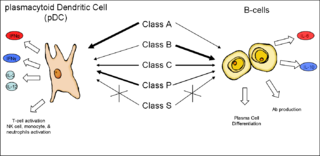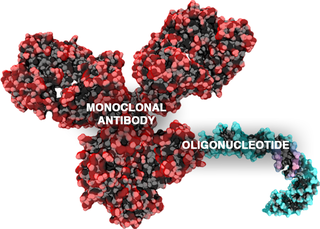Related Research Articles

Nucleotides are organic molecules composed of a nitrogenous base, a pentose sugar and a phosphate. They serve as monomeric units of the nucleic acid polymers – deoxyribonucleic acid (DNA) and ribonucleic acid (RNA), both of which are essential biomolecules within all life-forms on Earth. Nucleotides are obtained in the diet and are also synthesized from common nutrients by the liver.

Peptide nucleic acid (PNA) is an artificially synthesized polymer similar to DNA or RNA.

A DNA microarray is a collection of microscopic DNA spots attached to a solid surface. Scientists use DNA microarrays to measure the expression levels of large numbers of genes simultaneously or to genotype multiple regions of a genome. Each DNA spot contains picomoles of a specific DNA sequence, known as probes. These can be a short section of a gene or other DNA element that are used to hybridize a cDNA or cRNA sample under high-stringency conditions. Probe-target hybridization is usually detected and quantified by detection of fluorophore-, silver-, or chemiluminescence-labeled targets to determine relative abundance of nucleic acid sequences in the target. The original nucleic acid arrays were macro arrays approximately 9 cm × 12 cm and the first computerized image based analysis was published in 1981. It was invented by Patrick O. Brown. An example of its application is in SNPs arrays for polymorphisms in cardiovascular diseases, cancer, pathogens and GWAS analysis. It is also used for the identification of structural variations and the measurement of gene expression.

A locked nucleic acid (LNA), also known as bridged nucleic acid (BNA), and often referred to as inaccessible RNA, is a modified RNA nucleotide in which the ribose moiety is modified with an extra bridge connecting the 2' oxygen and 4' carbon. The bridge "locks" the ribose in the 3'-endo (North) conformation, which is often found in the A-form duplexes. This structure provides for increased stability against enzymatic degradation. LNA also offers improved specificity and affinity in base-pairing as a monomer or a constituent of an oligonucleotide. LNA nucleotides can be mixed with DNA or RNA residues in a oligonucleotide.

A Morpholino, also known as a Morpholino oligomer and as a phosphorodiamidate Morpholino oligomer (PMO), is a type of oligomer molecule used in molecular biology to modify gene expression. Its molecular structure contains DNA bases attached to a backbone of methylenemorpholine rings linked through phosphorodiamidate groups. Morpholinos block access of other molecules to small specific sequences of the base-pairing surfaces of ribonucleic acid (RNA). Morpholinos are used as research tools for reverse genetics by knocking down gene function.
Antisense therapy is a form of treatment that uses antisense oligonucleotides (ASOs) to target messenger RNA (mRNA). ASOs are capable of altering mRNA expression through a variety of mechanisms, including ribonuclease H mediated decay of the pre-mRNA, direct steric blockage, and exon content modulation through splicing site binding on pre-mRNA. Several ASOs have been approved in the United States, the European Union, and elsewhere.

Antisense RNA (asRNA), also referred to as antisense transcript, natural antisense transcript (NAT) or antisense oligonucleotide, is a single stranded RNA that is complementary to a protein coding messenger RNA (mRNA) with which it hybridizes, and thereby blocks its translation into protein. The asRNAs have been found in both prokaryotes and eukaryotes, and can be classified into short and long non-coding RNAs (ncRNAs). The primary function of asRNA is regulating gene expression. asRNAs may also be produced synthetically and have found wide spread use as research tools for gene knockdown. They may also have therapeutic applications.
In molecular biology, a hybridization probe (HP) is a fragment of DNA or RNA, usually 15–10000 nucleotides long, which can be radioactively or fluorescently labeled. HPs can be used to detect the presence of nucleotide sequences in analyzed RNA or DNA that are complementary to the sequence in the probe. The labeled probe is first denatured into single stranded DNA (ssDNA) and then hybridized to the target ssDNA or RNA immobilized on a membrane or in situ.
In molecular biology and genetics, the sense of a nucleic acid molecule, particularly of a strand of DNA or RNA, refers to the nature of the roles of the strand and its complement in specifying a sequence of amino acids. Depending on the context, sense may have slightly different meanings. For example, the negative-sense strand of DNA is equivalent to the template strand, whereas the positive-sense strand is the non-template strand whose nucleotide sequence is equivalent to the sequence of the mRNA transcript.
Oligonucleotide synthesis is the chemical synthesis of relatively short fragments of nucleic acids with defined chemical structure (sequence). The technique is extremely useful in current laboratory practice because it provides a rapid and inexpensive access to custom-made oligonucleotides of the desired sequence. Whereas enzymes synthesize DNA and RNA only in a 5' to 3' direction, chemical oligonucleotide synthesis does not have this limitation, although it is most often carried out in the opposite, 3' to 5' direction. Currently, the process is implemented as solid-phase synthesis using phosphoramidite method and phosphoramidite building blocks derived from protected 2'-deoxynucleosides, ribonucleosides, or chemically modified nucleosides, e.g. LNA or BNA.

A computational gene is a molecular automaton consisting of a structural part and a functional part; and its design is such that it might work in a cellular environment.

CpG oligodeoxynucleotides are short single-stranded synthetic DNA molecules that contain a cytosine triphosphate deoxynucleotide ("C") followed by a guanine triphosphate deoxynucleotide ("G"). The "p" refers to the phosphodiester link between consecutive nucleotides, although some ODN have a modified phosphorothioate (PS) backbone instead. When these CpG motifs are unmethylated, they act as immunostimulants. CpG motifs are considered pathogen-associated molecular patterns (PAMPs) due to their abundance in microbial genomes but their rarity in vertebrate genomes. The CpG PAMP is recognized by the pattern recognition receptor (PRR) Toll-Like Receptor 9 (TLR9), which is constitutively expressed only in B cells and plasmacytoid dendritic cells (pDCs) in humans and other higher primates.
A bridged nucleic acid (BNA) is a modified RNA nucleotide. They are sometimes also referred to as constrained or inaccessible RNA molecules. BNA monomers can contain a five-membered, six-membered or even a seven-membered bridged structure with a "fixed" C3'-endo sugar puckering. The bridge is synthetically incorporated at the 2', 4'-position of the ribose to afford a 2', 4'-BNA monomer. The monomers can be incorporated into oligonucleotide polymeric structures using standard phosphoramidite chemistry. BNAs are structurally rigid oligo-nucleotides with increased binding affinities and stability.
Anti-miRNA oligonucleotides have many uses in cellular mechanics. These synthetically designed molecules are used to neutralize microRNA (miRNA) function in cells for desired responses. miRNA are complementary sequences to mRNA that are involved in the cleavage of RNA or the suppression of the translation. By controlling the miRNA that regulate mRNAs in cells, AMOs can be used as further regulation as well as for therapeutic treatment for certain cellular disorders. This regulation can occur through a steric blocking mechanism as well as hybridization to miRNA. These interactions, within the body between miRNA and AMOs, can be for therapeutics in disorders in which over/under expression occurs or aberrations in miRNA lead to coding issues. Some of the miRNA linked disorders that are encountered in the humans include cancers, muscular diseases, autoimmune disorders, and viruses. In order to determine the functionality of certain AMOs, the AMO/miRNA binding expression must be measured against the expressions of the isolated miRNA. The direct detection of differing levels of genetic expression allow the relationship between AMOs and miRNAs to be shown. This can be detected through luciferase activity. Understanding the miRNA sequences involved in these diseases can allow us to use anti miRNA Oligonucleotides to disrupt pathways that lead to the under/over expression of proteins of cells that can cause symptoms for these diseases.
A hybridization assay comprises any form of quantifiable hybridization i.e. the quantitative annealing of two complementary strands of nucleic acids, known as nucleic acid hybridization.

Antibody-oligonucleotide conjugates or AOCs belong to a class of chimeric molecules combining in their structure two important families of biomolecules: monoclonal antibodies and oligonucleotides.
RNA therapeutics are a new class of medications based on ribonucleic acid (RNA). Research has been working on clinical use since the 1990s, with significant success in cancer therapy in the early 2010s. In 2020 and 2021, mRNA vaccines have been developed globally for use in combating the coronavirus disease. The Pfizer–BioNTech COVID-19 vaccine was the first mRNA vaccine approved by a medicines regulator, followed by the Moderna COVID-19 vaccine, and others.
Gapmers are short DNA antisense oligonucleotide structures with RNA-like segments on both sides of the sequence. These linear pieces of genetic information are designed to hybridize to a target piece of RNA and silence the gene through the induction of RNase H cleavage. Binding of the gapmer to the target has a higher affinity due to the modified RNA flanking regions, as well as resistance to degradation by nucleases. Gapmers are currently being developed as therapeutics for a variety of cancers, viruses, and other chronic genetic disorders.

A majority of the human genome is made up of non-protein coding DNA. It infers that such sequences are not commonly employed to encode for a protein. However, even though these regions do not code for protein, they have other functions and carry necessary regulatory information.They can be classified based on the size of the ncRNA. Small noncoding RNA is usually categorized as being under 200 bp in length, whereas long noncoding RNA is greater than 200bp. In addition, they can be categorized by their function within the cell; Infrastructural and Regulatory ncRNAs. Infrastructural ncRNAs seem to have a housekeeping role in translation and splicing and include species such as rRNA, tRNA, snRNA.Regulatory ncRNAs are involved in the modification of other RNAs.
This glossary of cellular and molecular biology is a list of definitions of terms and concepts commonly used in the study of cell biology, molecular biology, and related disciplines, including molecular genetics, biochemistry, and microbiology. It is split across two articles:
References
- ↑ Yang J, Stolee JA, Jiang H, Xiao L, Kiesman WF, Antia FD, et al. (October 2018). "Solid-Phase Synthesis of Phosphorothioate Oligonucleotides Using Sulfurization Byproducts for in Situ Capping". The Journal of Organic Chemistry. 83 (19): 11577–11585. doi:10.1021/acs.joc.8b01553. PMID 30179468. S2CID 52157806.
- ↑ Qureshi A, Thakur N, Monga I, Thakur A, Kumar M (1 January 2014). "VIRmiRNA: a comprehensive resource for experimentally validated viral miRNAs and their targets". Database. 2014: bau103. doi:10.1093/database/bau103. PMC 4224276 . PMID 25380780.
- 1 2 Monga I, Qureshi A, Thakur N, Gupta AK, Kumar M (2017). "ASPsiRNA: A Resource of ASP-siRNAs Having Therapeutic Potential for Human Genetic Disorders and Algorithm for Prediction of Their Inhibitory Efficacy". G3: Genes, Genomes, Genetics . 7 (9): 2931–2943. doi:10.1534/g3.117.044024. PMC 5592921 . PMID 28696921.
- ↑ Weiss, B., ed. (1997). Antisense Oligodeoxynucleotides and Antisense RNA : Novel Pharmacological and Therapeutic Agents. Boca Raton, Florida: CRC Press
- ↑ Weiss B, Davidkova G, Zhou LW (1999). "Antisense RNA gene therapy for studying and modulating biological processes". Cellular and Molecular Life Sciences. 55 (3): 334–58. doi:10.1007/s000180050296. PMID 10228554. S2CID 9448271.
- 1 2 3 Dias N, Stein CA (March 2002). "Antisense oligonucleotides: basic concepts and mechanisms". Molecular Cancer Therapeutics. 1 (5): 347–55. PMID 12489851.
- ↑ Frazier KS (January 2015). "Antisense oligonucleotide therapies: the promise and the challenges from a toxicologic pathologist's perspective". Toxicologic Pathology. 43 (1): 78–89. doi:10.1177/0192623314551840. PMID 25385330. S2CID 37981276.
- 1 2 3 4 DeVos SL, Miller TM (July 2013). "Antisense oligonucleotides: treating neurodegeneration at the level of RNA". Neurotherapeutics. 10 (3): 486–97. doi:10.1007/s13311-013-0194-5. PMC 3701770 . PMID 23686823.
- 1 2 Eckstein F (April 2000). "Phosphorothioate oligodeoxynucleotides: what is their origin and what is unique about them?". Antisense & Nucleic Acid Drug Development. 10 (2): 117–21. doi:10.1089/oli.1.2000.10.117. PMID 10805163.
- ↑ Stein CA, Subasinghe C, Shinozuka K, Cohen JS (April 1988). "Physicochemical properties of phosphorothioate oligodeoxynucleotides". Nucleic Acids Research. 16 (8): 3209–21. doi:10.1093/nar/16.8.3209. PMC 336489 . PMID 2836790.
- 1 2 Michel BY, Dziuba D, Benhida R, Demchenko AP, Burger A (2020). "Probing of Nucleic Acid Structures, Dynamics, and Interactions With Environment-Sensitive Fluorescent Labels". Frontiers in Chemistry. 8: 112. Bibcode:2020FrCh....8..112M. doi: 10.3389/fchem.2020.00112 . PMC 7059644 . PMID 32181238.
- 1 2 Crooke ST (April 2017). "Molecular Mechanisms of Antisense Oligonucleotides". Nucleic Acid Therapeutics. 27 (2): 70–77. doi:10.1089/nat.2016.0656. PMC 5372764 . PMID 28080221.
- ↑ Heasman J, Kofron M, Wylie C (June 2000). "Beta-catenin signaling activity dissected in the early Xenopus embryo: a novel antisense approach". Developmental Biology. 222 (1): 124–34. doi: 10.1006/dbio.2000.9720 . PMID 10885751.
- ↑ Kumar P, Kumar B, Rajput R, Saxena L, Banerjea AC, Khanna M (November 2013). "Cross-protective effect of antisense oligonucleotide developed against the common 3' NCR of influenza A virus genome". Molecular Biotechnology. 55 (3): 203–11. doi:10.1007/s12033-013-9670-8. PMID 23729285. S2CID 24496875.
- ↑ Kumar B, Khanna M, Kumar P, Sood V, Vyas R, Banerjea AC (May 2012). "Nucleic acid-mediated cleavage of M1 gene of influenza A virus is significantly augmented by antisense molecules targeted to hybridize close to the cleavage site". Molecular Biotechnology. 51 (1): 27–36. doi:10.1007/s12033-011-9437-z. PMID 21744034. S2CID 45686564.
- ↑ Smith RA, Miller TM, Yamanaka K, Monia BP, Condon TP, Hung G, et al. (August 2006). "Antisense oligonucleotide therapy for neurodegenerative disease". The Journal of Clinical Investigation. 116 (8): 2290–6. doi: 10.1172/JCI25424 . PMC 1518790 . PMID 16878173.
- ↑ Ming, Xin; Alam, Md Rowshon; Fisher, Michael; Yan, Yongjun; Chen, Xiaoyuan; Juliano, Rudolph L. (2010-06-15). "Intracellular delivery of an antisense oligonucleotide via endocytosis of a G protein-coupled receptor". Nucleic Acids Research. 38 (19): 6567–6576. doi:10.1093/nar/gkq534. ISSN 1362-4962. PMC 2965246 . PMID 20551131.
- 1 2 Hawner, Manuel; Ducho, Christian (2020-12-16). "Cellular Targeting of Oligonucleotides by Conjugation with Small Molecules". Molecules. 25 (24): 5963. doi: 10.3390/molecules25245963 . ISSN 1420-3049. PMC 7766908 . PMID 33339365.
- 1 2 Crooke, S. T. (2017). "Cellular uptake and trafficking of antisense oligonucleotides". Nat. Biotechnol. 35 (3): 230–237. doi:10.1038/nbt.3779. PMID 28244996. S2CID 1049452.
- ↑ Prakash, Thazha P.; Graham, Mark J.; Yu, Jinghua; Carty, Rick; Low, Audrey; Chappell, Alfred; Schmidt, Karsten; Zhao, Chenguang; Aghajan, Mariam; Murray, Heather F.; Riney, Stan; Booten, Sheri L.; Murray, Susan F.; Gaus, Hans; Crosby, Jeff (July 2014). "Targeted delivery of antisense oligonucleotides to hepatocytes using triantennary N-acetyl galactosamine improves potency 10-fold in mice". Nucleic Acids Research. 42 (13): 8796–8807. doi:10.1093/nar/gku531. ISSN 1362-4962. PMC 4117763 . PMID 24992960.
- ↑ Buszewski B, Kasturi P, Gilpin RK, Gangoda ME, Jaroniec M (August 1994). "Chromatographic and related studies of alkylamide phases". Chromatographia. 39 (3–4): 155–61. doi:10.1007/BF02274494. S2CID 97825477.
- ↑ Buszewski B, Safaei Z, Studzińska S (January 2015). "Analysis of oligonucleotides by liquid chromatography with alkylamide stationary phase". Open Chemistry. 13 (1). doi: 10.1515/chem-2015-0141 .
- ↑ Gilar, M.; Fountain, K. J.; Budman, Y.; Neue, U. D.; Yardley, K. R.; Rainville, P. D.; Russell Rj, 2nd; Gebler, J. C. (2002-06-07). "Ion-pair reversed-phase high-performance liquid chromatography analysis of oligonucleotides:: Retention prediction". Journal of Chromatography A. 958 (1–2): 167–182. doi:10.1016/S0021-9673(02)00306-0. ISSN 0021-9673. PMID 12134814.
{{cite journal}}: CS1 maint: numeric names: authors list (link) - ↑ Distler AM, Allison J (April 2001). "5-Methoxysalicylic acid and spermine: a new matrix for the matrix-assisted laser desorption/ionization mass spectrometry analysis of oligonucleotides". Journal of the American Society for Mass Spectrometry. 12 (4): 456–62. Bibcode:2001JASMS..12..456D. doi:10.1016/S1044-0305(01)00212-4. PMID 11322192. S2CID 18280663.
- ↑ Shah S, Friedman SH (March 2008). "An ESI-MS method for characterization of native and modified oligonucleotides used for RNA interference and other biological applications". Nature Protocols. 3 (3): 351–6. doi:10.1038/nprot.2007.535. PMID 18323805. S2CID 2093309.
- ↑ Relógio A, Schwager C, Richter A, Ansorge W, Valcárcel J (June 2002). "Optimization of oligonucleotide-based DNA microarrays". Nucleic Acids Research. 30 (11): 51e–51. doi:10.1093/nar/30.11.e51. PMC 117213 . PMID 12034852.
- ↑ Gong P, Harbers GM, Grainger DW (April 2006). "Multi-technique comparison of immobilized and hybridized oligonucleotide surface density on commercial amine-reactive microarray slides". Analytical Chemistry. 78 (7): 2342–51. doi:10.1021/ac051812m. PMID 16579618.